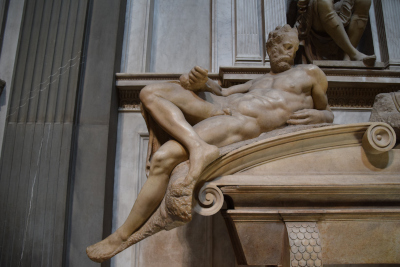Introduction
Michelangelo's work on the two sculptures spanned the period of 1524-31, though he would have spent much of this time distracted by other projects too. In commissioning Michelangelo to produce multiple artworks within the same building, consistency between them was assured and this was particularly important because of how the sculptures would be laid out, on opposing sides. Any stylistic variations between Dawn and Dusk would have been observed by even the most occassional of art follower.
It was also likely more efficient to cover the sculptures together at the same time, and Michelangelo would often fail to complete other commissions within his career, where distractions occurred, or politics interfered with his creative process. Thankfully, the vast majority of these two sculptures was completed on time, certainly enough to enable them to be displayed, just as they are today.
Michelangelo was highly favoured by the Medici family and they provided him with a number of high profile commissions. His relationship with them proved highly beneficial at times, but was also fraught with danger, because of the constantly changing tides of Italian politics during that period. The respect afforded to him by the Medicis is typified by the awarding of this series of sculptures to him.
Table of Contents
Description
Michelangelo's Dawn features an elderly man reclining backwards, with his weight balanced by his left arm. His right hand reaches over from the side, and is rested on his right leg. His posture appears relaxed, as the same right leg is angled to sit upon the left leg which reaches down to the lowest point of this sculpture. The style of this male portrait is entirely typical of Michelangelo, who liked to incorporate toned torsos, which we can see again here.
One can immediately see that Michelangelo planned Dusk and Dawn with the intention of them being displayed in this manner, with legs stretching away from the central point of the tomb, producing a triangular format, with the portrait of Duke Lorenzo providing the centerpiece. Michelangelo completed work on another tomb within the same building, and this followed a similar approach, ensuring an impressive level of consistency between the two tombs.
In terms of the detail within this specific piece, the abdominal muscles and beautifully crafted, producing an ideal form of the male body, which did not realistically fit with the age of the figure, when judging his facial features. The sculptor was essentially trying to portray a man of wisdom, and beauty, and so combined elements of youthful health with age, knowledge and maturity.
The elderly figure has a receding hairline, long, prominent nose and a thick beard as he looks downwards, in our direction. The piece was sculptured from a large block of marble, some of which still remains within the sculpture and provides its base, whilst it is perched on the architectural features of the tomb itself. Michelangelo sometimes would leave elements of the original stone in his sculptures, and this gave those pieces a feeling of organic growth, as if the figures have appeared and grown from within the stone, rather than from the work of an artist.
Dusk and Dawn left Unfinished
Whilst being considered stunning artworks in their own right, neither Dusk nor Dawn were entirely completed. Visitors to the tomb may notice elements around their hands and feet where the original stone has not yet been removed, and even some work left to their faces. Despite this, Michelangelo's work within the tomb can be considered relatively efficient, when compared to other parts of his career.
Political turbulence or his own ever changing mood led to a number of other commissions being abandoned at far earlier stages than we find here. The elements left over were also not key to each piece, and so we can enjoy both items, treating them as if they were actually finished.
Inspiration
Scholars have examined Michelangelo's work within the tomb of Lorenzo de' Medici in great detail and attempted to discover where the sculptor's inspiration for these designs came from. A common belief that is often put forward regarding Dusk, is that it was Michelangelo's adoration for the Arch of Septimius Severus in Rome that may have played a role in how he planned this piece.
Around the rim of the arch, there are a number of figures, stretched out around the curved architecture, and presumably this is the section that scholars believe may have influenced the great master. The arch itself was completed in around 200AD.
Art history often goes in cycles, from one movement or generations to the next. Whilst Michelangelo would marvel at classical art and architecture in order to find inspiration for his work within the tomb of Lorenzo de' Medici, the same approach would be taken by later artists who would hold his career in great reverence. Many sketches were made from professional and amateur artists who would sit in front of these sculptures and carefully draw studies of them.
Michelangelo was known particularly as a master of the human anatomy, and so artists believed they could learn some of his techniques by creating their own copies of his work - this was obviously more common before the modern media, as well as photography, brought artists new ways of studying art from the past.
Michelangelo would also survey other artists from the Renaissance, in order to learn from them too. This was particularly the case earlier in his career, where the influence of Domenico Ghirlandaio was at its strongest.
However, he was more of a painter, and Michelangelo would need to find alternative sources for his work as a sculptor. There was plenty of resources for this, particularly in Florence and Italy art at that time had an effective system for passing skills on from one generation to the next. Michelangelo's work for the Medicis brought many new opportunities and experiences which helped to fill in any gaps of knowledge in his early days as an artist.
Size and Medium
Michelangelo's Dusk was completed entirely in marble, as with most of his career sculptures, and some of the original rock was left within the piece in a style typical of this sculptor. The statue itself measures 195 cm in length, and the precise date in which is was completed is hard to determine because of how it was a smaller part of a much larger project which spanned over a decade of work.
Image Credits
The image included within this page is provided under the Creative Commons Attribution 2.0 Generic license from Wikimedia Commons. The original contributor was George M. Groutas, via Flickr, and their work is very much appreciated. We encourage you to view more of their contributions to Wikimedia, many of which will also be related to Italian Renaissance art.
Dusk, 1524-1534 by Michelangelo, sculpture within the New Sacristy; George M. Groutas, CC BY-SA 2.0, via Wikimedia Commons
Bibliography
- Images sourced from Wikimedia under a variety of Creative Commons licenses. Further details regarding the particular license used, the location of the original image on Wikimedia and the original author/user are provided on each specific page.
- Michelangelo, Gilles Néret
- Vasari's Lives of the Artists, Giorgio Vasari
- Michelangelo. The Complete Works. Paintings, Sculptures, Architecture, Frank Zöllner, Christof Thoenes
- Michelangelo and the Sistine Chapel, Andrew Graham-Dixon





